A gay old time in Paestum
After a couple of days in Salerno, it was time to spread our wings and venture out. Our new maps and bus schedules in hand, we considered our options.
“There’s Paestum,†suggested the Ant.
Now, I’m basically tagging along on this portion of the trip, so I’ve done embarrassingly little research into the area. I’d never even heard of Paestum. So I picked up my handy-dandy tourist guide and learned a couple of fun facts about Paestum. First, Paestum has the largest collection of Greek temples outside of Greece. Coolness. My family is Greek and Italian. We’re other things, too, but we mostly claim the Greek and Italian. This sounded like our kind of place.
Second, I learned that Paestum was deserted when most of the population was wiped out by mosquitoes carrying malaria. That’s much of the reason the temples remain intact. Not good. But not surprising.
The Ant and I had spent the first two nights battling insane mosquito-like beasts. These things were big. I could hear them winging their way toward my headlamp each night while I was reading Pema Chodron and trying to find a little peace. An interesting challenge.
And they did something funny to our skin.
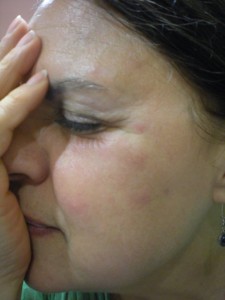
This is two days after the Ant was bitten about 6 times on the side of her face. I was bitten, I believe, 3 times on the ear, (it was hard to tell how many times, due to the intense swelling and redness) and it’s still itching, 2 weeks later. At least the open wound has healed up. The 20 or so other bites on my face and legs never really took hold. I’ve just been considering this training for Survivor. Regardless, these things are bad news.
Brimming with understanding of our Greek/Roman mosquito-bate ancestors, we hopped a bus to Paestum. That’s Pa-ace-toom. Get it right. Or the bus driver will act like he doesn’t understand where you’re trying to go. Then he’ll correct your pronunciation. Or maybe that was just my experience.
I sat in my seat, going over it in my head: “pa-ace-toom, pa-ace-toom, pa-ace-toom.â€Â I’d have to ask him later if we were getting close.
We scuttered along through town after town, noting the differences in the styles of apartment buildings, or the way people hung their laundry.
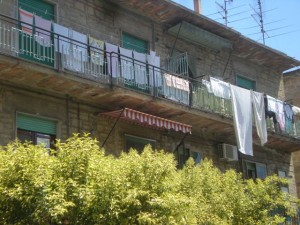
The country got wilder, and more open and we wondered how much further. Passengers ebbed and flowed along the winding track we took to the ruins. Tourists, workers, grandmothers, coming and going between the villages.
We saw a municipal sign of some sort. “Welcome to Paestum†or something similar. When we’re traveling by bus, there’s often not much to tell us where we are, other than signs on buildings. If we miss the sign at the beginning of a town, we could go the entire length of the town without having a clue where we are. This big sign for Paestum was more than we usually get. We grabbed our bags and jumped up, moving forward several rows to make sure the bus driver could see us. When the bus stopped, he signaled to us. “No.â€Â We weren’t there yet? Wow. Our fool-proof method had failed us. How many stops could there be in Paestum?
20 minutes later, we were still driving. Whoops! I was starting to like our bus driver more and more.
I consulted the pages I’d torn from my trusty Rick Steves book; we tried to find our location on the Ant’s smart phone. No use. Rick said the bus would let us off outside the old city walls. I peeled my eyes and kept them on the horizon for city walls of some kind.
When we finally rumbled up to a lonely gelato shop at the intersection of two country roads, I was a little surprised to hear the driver bellow, “Pa-ace-toom!†and wave us forward.
“Qua?â€Â I wanted to make sure. “Pa-ace-toom.â€Â He just nodded again, but this time smiled.
“Ciao, grazie!â€Â we smiled as we climbed off alone.
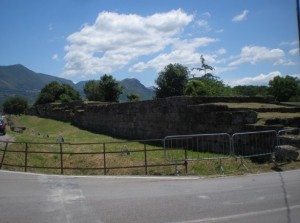
The city walls were there, low, thick, and old. We smiled at the folks under big umbrellas outside the gelato shop, and walked inside the ancient city walls.
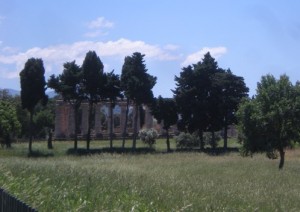
“That’s a good sign,†I said, jerking my head in the direction of the trees and columns.
We located the ticket office, purchased our combo ticket for the temples and the museum, and headed out into the fenced field bordered by vendors selling trinkets.
We spent the next two hours walking through the tall, flowing grasses, looking up at the temples.
It’s amazing how much I find myself affected by places like this. I find I could sit on a hunk of rock and contemplate my ancestors for hours, days, ever maybe.
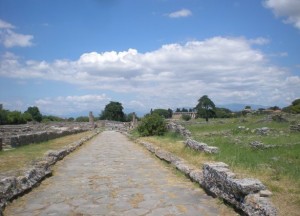
The Ant read a sign about the destructive lichen eating away the ruins, and decided she’d come back with a toothbrush to volunteer her time and rid the temples of the beast. I thought it was pretty.
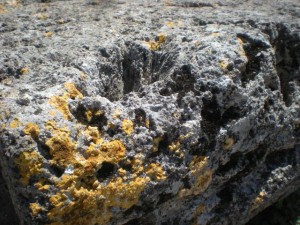
As we walked, we talked absentmindedly about the Greeks and their superiority, and I thought about the first time I’d seen Greek ruins up close. It was on a trip to Greece with my family when I was a teenager. We were looking for family, but taking in some sights along the way. I spent the day at Olympus with my dad, Greek grandfather, and uncle. I remember clearly the feeling of disgust I had for the people of Greece. How could they let their precious temples be ruined like this? Why didn’t they stand the columns back up?
Hilarious.
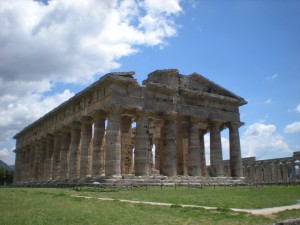
In Paestum, I was amazed at how intact the temples were. So much so that we could do side-by-side comparisons of architectural changes over 500 years. Brilliant.
At the end of two hours of strolling and thinking in the sun, we were starving. It was most assuredly time for pizza. After a ridiculous episode whereby we unknowingly tried to enter a restaurant from the back side, left in a bit of a huff, walked 4 blocks and unwittingly ended up entering the same restaurant from the correct direction, we were seated with 2, count them 2, huge bottles of water in front of us.
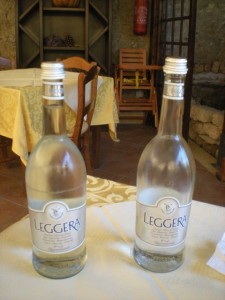
Note: the Ant and I carry our own water bottles with us wherever we go. By this time we had consumed every drop. The only way to really get water in a restaurant in Italy is to buy it. From a bottle. Or to fill in the restroom, which we do regularly. Today, we bought water.
On our first attempt to enter the restaurant, we’d spotted a menu and scoped out the pizzas. We already had our favorites picked out: cherry tomatoes and rocket for the Ant, squash blossom for me.
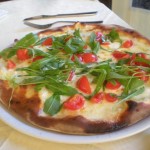
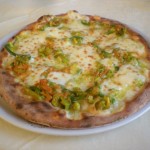
One bottle of water already in our stomachs, we scarfed these heavenly pizzas down. Most pizzas come served whole in Italy, with a knife and fork. You get to cut to size and eat however you see fit. Some people cut pieces and eat with their hands. Some cut slices and then cut them into smaller pieces to eat with a fork. Others eat the center, and leave the crust (I consider this a great crime). On days like today, we start with big pieces folded and stuffed in our faces, then cut smaller and smaller pieces, packing the dough and cheese in.
Whatever water was left, we poured into our empty bottles and prepared for the second half of the day:Â the museum.
The second great historical site at Paestum is the tomb of the diver. Dating back to the Greeks, this sarcophagus is rare, maybe unique in its preservation (thanks, mosquitos). The insides of the box were painted with scenes to entertain the dead. The lid of this one was painted with an image of a diver, gracefully leaping from a great height into the unknown, a peaceful look and feel about him.
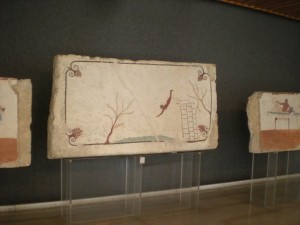
The walls of the box were painted with scenes from a party. A very festive party. Perhaps even a very gay party…
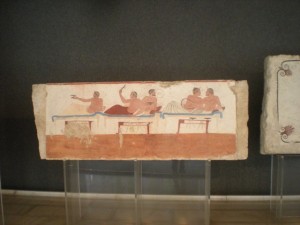
As we stood and looked at the panels, a tour group of British school-kids came through with a tour guide. I stood nearby to catch a free lesson.
“The panels depict a typical party. The first man sits on a sofa, beckoning for more wine, waiting in anticipation. The second grouping shows two men playing a game in which a plate is balanced on a stick, and the last drop of wine is flicked from the glass in an attempt to hit the plate, knocking it to the floor.â€
He paused.
“The third group shows one man playing an instrument, and engaged in a show of affection,†another pause, “more than just enjoying each other’s company.â€Â The kids looked closer. The guide continued:
“Now I’m not one to say whether this is a scene of homo-eroticism, but that is the prevailing view of the experts.† I chuckled a little. The musician was all but pinching the other guy’s nipple. Maybe I should consider a career in ancient Greek art.
Feeling like we should make use of our museum tickets, we cruised through, checked out the super-old bronze vases, and penis-shaped pots. Gay.
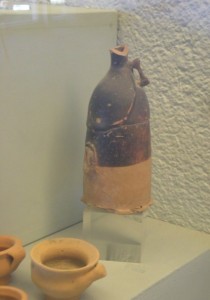
Leaving the museum, we praised the gods and goddesses for the lack of present-day mosquitoes in Paestum. We’d commune with our ancestors later. For me, I’d found other connections with my ancient brothers and sisters. Any people who celebrated ceramic sexuality, squash-blossoms, and leaps into the unknown were my people.
June 18, 2010 1 Comment


